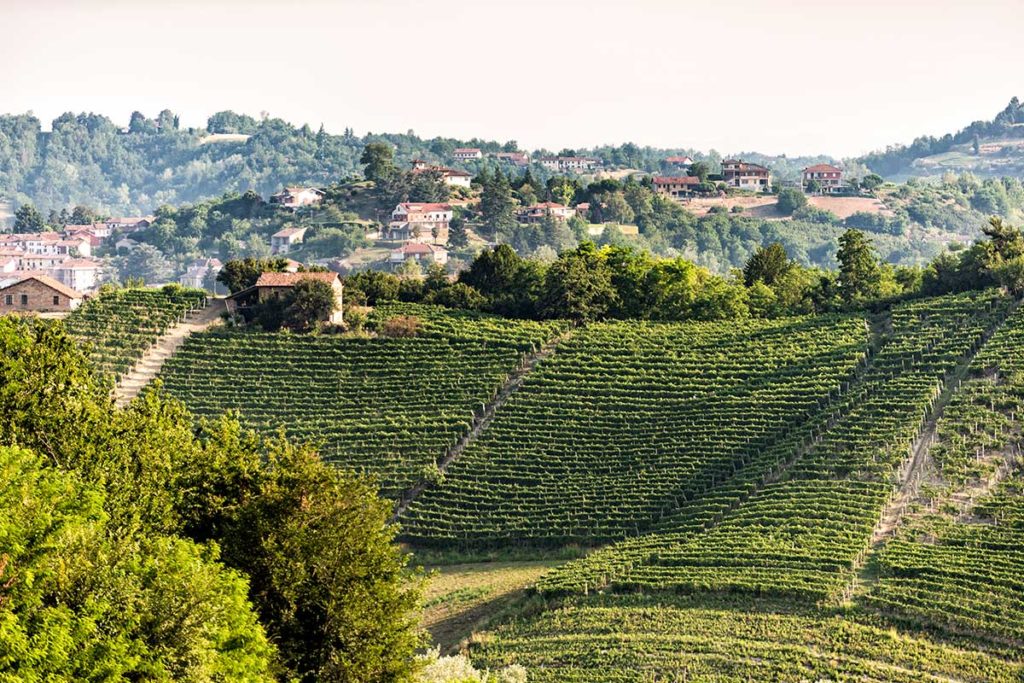Hills chasing each other as far as the eye can see, perched medieval villages that seem to hang on the horizon, ancient farmhouses and fine wine cellars: this is the landscape of Monferrato, and it is here that man and nature have always lived in symbiosis.
‘Exploiting the land’ does not mean draining it, but rather making use of what nature provides, enhancing the fruits of the encounter between man and nature. A relationship of mutual support and help, rather than one of domination and prevarication, which makes Monferrato territory appear today as one enormous demonstration of love.
Monferrato is a frank, sincere land, like its people, and its treasures are not hidden from the eyes of those who know how to look. All you have to do is lift your foot off the gas pedal a little, roll down the window and observe your surroundings. Here is the ‘green sea of Sarmassa’ praised by Davide Lajolo, which nestles between the waves of land and the vineyards, capable of producing some of the most exceptional wines in the world.



The wine-growing landscapes of Piedmont: Langhe-Roero and Monferrato in the World Heritage List.
It was the 22nd of 2014 when the UNESCO World Heritage Committee, with Decision No. 38 COM 8B.41, registered ‘The wine-growing landscapes of Piedmont: Langhe-Roero and Monferrato’ in the World Heritage List. We remember it as if it were the day Italy won the football World Cup. Not because it was unexpected news, but because it also meant a recognition of the hard work of all the members of Cooperativa Vinchio Vaglio.
The decision came unanimously, and it rewards the strong cultural and historical identity of our territory, which is inextricably connected to the production of excellent wines.
Contrary to popular belief, in fact, the hills of Piedmont have not become a UNESCO heritage site ‘only’ for their undoubted landscape beauty, but also for the historical value of tradition. A true wine culture, deeply rooted in the community and in the craftsmanship of the Piedmontese.
The UNESCO site is a serial one, meaning that it is made up of six areas (called ‘components’) articulated within the borders of the provinces of Alessandria, Asti and Cuneo and of twenty-nine municipalities, for a total extension of 10,789 hectares.
The focal point of each component is the special connection between grape variety, terroir and winemaking technique. For this reason, the area located in the Province of Asti has obviously been included within the territory of Barbera vine, a variety that has been cultivated for over 500 years in the Piedmont region.




Cantina Cooperativa Vinchio Vaglio within the UNESCO core zone
Each one of our vineyards belongs to the World Heritage List: from the youngest to the oldest vines, and this fills us with pride. If the territory is what we see now, it is also thanks to all the members of Cantina Cooperativa Vinchio Vaglio who, since 1959, have been spending every drop of their own sweat to cultivate these impervious hills.
The UNESCO recognition is not only about the beauty of the vineyards, but also for the promotion of wine culture, and the history of Cantina Vinchio Vaglio fits perfectly as a symbolic place for the development of the community and viticulture.
It is no coincidence that almost all our children grew up playing tag amongst the vineyards. Many educators would – rightly – turn up their noses today, yet dipping their dummies in the new wine tells of the importance of being born, growing up and living in an area so strongly characterised by the fruits of the earth.
It is thus that, despite the social, technological and economic evolutions linked to vine cultivation, nowadays the valorisation of the land still plays a key role in our community.
The UNESCO recognition adds in fact another reason for responsibility for the future. As a Cooperative Winery, we feel it is our duty to preserve the exceptional value of the site, respecting the technical and legal measures, but above all transmitting the values we believe in.
This is how Cantina Cooperativa Vinchio Vaglio represents an element of narration in the historicity of the territory. This is why it is a priority to continue using our resources with the care that distinguishes us, with an eye to environmental sustainability and the enhancement of our beautiful territory. The vine protection projects, the nesting track and all the innovations that have been made in recent years go precisely in this direction. Because if the purpose of the UNESCO certification is to safeguard the territory, it is up to us to do our best to make this happen.
The winery is a place of enjoyment for the palate, for the eyes, but it is also a place of encounter, culture and traditions.

Where is the best place to admire Monferrato?
In order to enjoy the panorama of the Monferrato UNESCO World Heritage site, we recommend you to go to the area of Rocca Castello di Vinchio. A belvedere that shows all the beauties of the UNESCO wine landscapes while standing on the ancient ruins of the castle destroyed back in the 19th century.
At the end of the visit, we’ll be waiting for you in the winery for a glass (or two) of Barbera.


